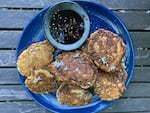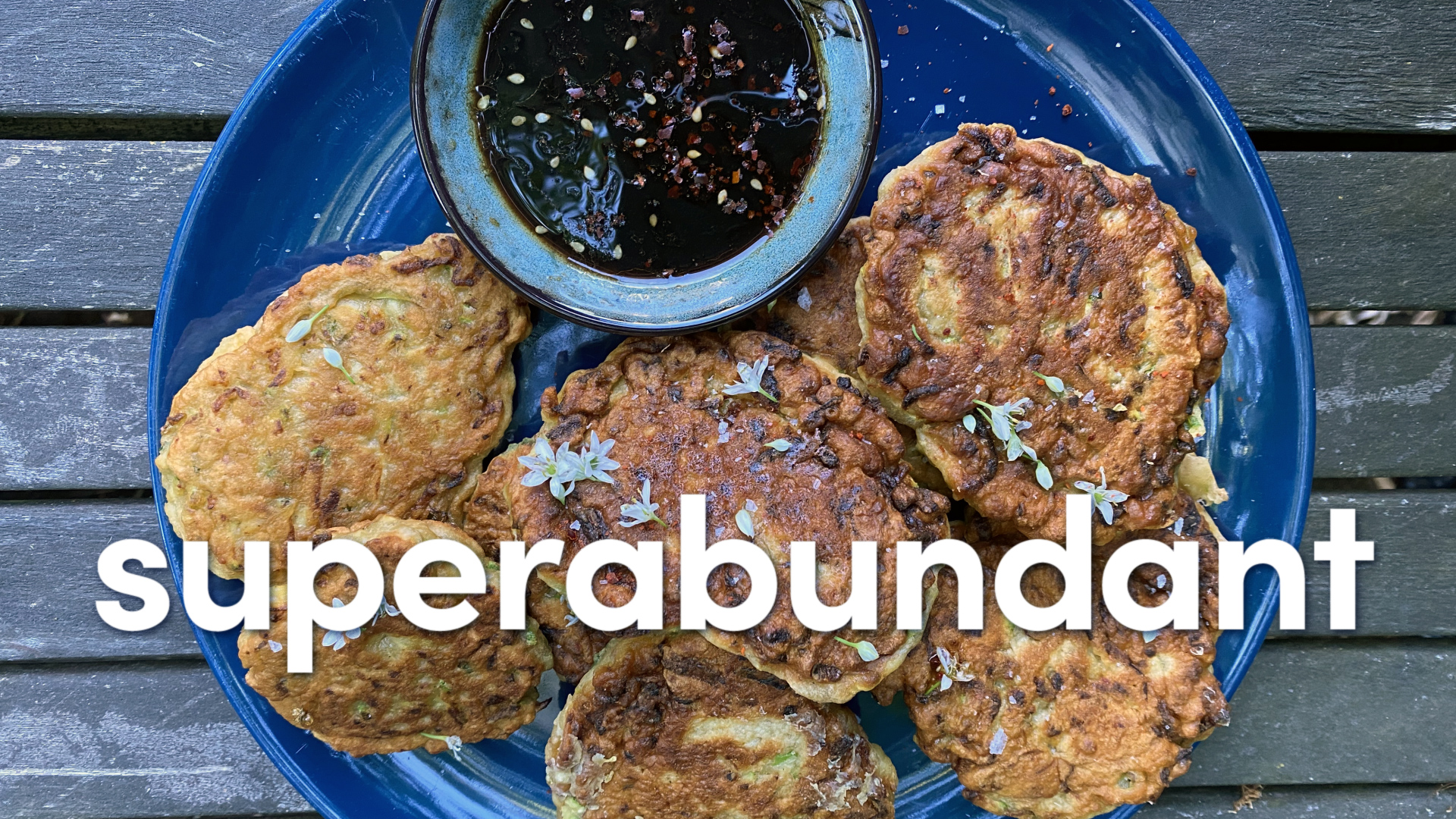OPB’s “Superabundant” explores the stories behind the foods of the Pacific Northwest with videos, articles and this weekly newsletter. To keep you sated between episodes, Heather Arndt Anderson, a Portland-based culinary historian, food writer and ecologist, highlights different aspects of the region’s food ecosystem. This week she offers tips for using all that zucchini you’re growing, including a recipe for hobak buchim (Korean zucchini fritters).
Click here to subscribe. For previous stories, go here.

Mid-July, and the livin’ is easy. If you love fresh fruits and vegetables, it’s the best time of the best season. A lot of people know about our salmon canneries, but the Northwest has a long history of fruit and vegetable preservation too — the bulk of our fresh crop goes straight to the freezer, the jam jar and the tin can. One company, now best known for its ready-to-eat survival and backpacking food is celebrating its 60th birthday this year — what Oregon product gave Oregon Freeze Dry its start? Read on to find out!
The survey results are in: our readers are the best! Plus a creepy-crawly threat to the Oregon wine industry, a look back at freeze-dried camp food and what’s good in gardens and markets
Freshly picked morsels from the Pacific Northwest food universe:
Readers, we heard you!
The survey results are in, and we are bowled over by the love all you have for “Superabundant” and the newsletter. You’re such an informed audience — many of you expressed interest in complicated issues like how climate change impacts food sovereignty, and how to get the most out of your food dollar by scouring for deals in the markets, foraging, and by stretching or swapping ingredients. You enjoy reading about the Northwest’s natural and culinary history. And most of all, you like the recipes and are hungry for MORE. In addition to the in-depth nerdy content you crave, expect to see more budget-friendly meals and recipes that don’t require a lot of specialty ingredients (though we do hope you’ll step out of your comfort zone to try something new here and there). Thank you again to everyone who completed the survey!
Invasive vine mealybugs reach Oregon vineyards
An insect pest that’s plagued California vineyards for the past three decades has made its way to Southern Oregon’s wine country. OPB’s Dave Miller spoke about it with Brian Gruber, president of the Oregon Winegrowers Association on “Think Out Loud.” Listen to that interview here.
Freeze-dried camp food maker celebrates 60 years
What do fruity breakfast cereals, military rations and backcountry hiking food have in common? They all use freeze-dried products created in Oregon. Though Albany-based Oregon Freeze Dry (OFD) got its start dehydrating Oregon strawberries for Post Corn Flakes & Strawberries breakfast cereal in 1963, they soon pivoted to Long Range Patrol rations (“lurps”) for the Vietnam War. OFD offloaded their military ration surplus onto sporting goods stores, and realizing the demand for lightweight, easy-to-prepare meals for campers and other outdoorsy types, they launched their brand Mountain House in 1969, and now make a range of emergency preparedness kits in addition to their camp-friendly fare. Of course, there are other ways to prepare for the Big One, but we prefer a lighter-weight option for our emergency go-bags.
In the “Superabundant” garden this week
The garden is presently an utter tangle. What were we thinking, planting bushy Whipple shelling beans so close to the summer squash and tomatillos? (To be fair, the beans came from a bag of splurgy Rancho Gordos and we didn’t read up on their growth habit until it was too late.) The super-old winter squash seeds we found in the bottom of the seed bin in May ended up being viable after all, so now one whole raised bed is a wrestling match between the banana squash, black futsu and petite butternuts (there may be a Cinderella pumpkin in there as well). May the best squash win! Cucumbers are being harvested every day, and there are even enough of the Double Yield cukes to make a quart of pickles. The Korean chiles and sweet Italian peppers are very productive. Tomatoes are still coming in dribs and drabs, mainly just for snacking straight from the plant. The garlic chives are all blooming, ready to add little crunchy pops of garlicky sweetness to salads and noodles.
Good things in markets
Tomatoes may be sluggish in the “Superabundant” garden, but they are popping in markets, along with beautiful red okra, marbled eggplants, shishito peppers, summer squash and cucumbers. Stone fruits are still going strong (peaches from east of the Cascades are spectacular right now and farms in the Tri-County area have U-picks galore), though cherries are on their way out. Caneberries like blackberry and loganberry are ready for your jam jars. Cantaloupes and albacore tuna are starting to make an appearance, and if you’re lucky you might still find strawberries in some locations.

Korean-style fritters are one thing you can do when you have too much zucchini.
Heather Arndt Anderson / OPB
Recipe: Hobak buchim (Korean zucchini fritters)
In this week’s installment of “Please Save Me From All This Superabundance,” we rescue you from a deluge of summer squash. Whether you grow zucchini, pattypans, yellow crooknecks, hobak or calabacitas, you are likely just seeing the tip of the summer squash iceberg and we’re here to help. (And stay tuned — OSU’s Master Gardener Program will host “Zucchini Week” on Instagram in mid-August.) If you don’t do a lot of pickling (which you should!), shredding summer squash makes it freeze much better — just grate it, lay it on a clean kitchen towel (line it with a paper towel if you have pets; their hair gets on everything), press out the liquid and freeze it flat in zip-top freezer bags. To save yourself hassle later, you can measure out and individually bag 1- or 2-cup portions.
Shredded zucchini is key to zucchini bread of course, but you can add it to savory quickbreads or pasta sauces to sneak in a little extra veg. It’s also great in chow-chow and giardiniera (both relishes are very easy to can using the boiling water bath method). This is one of our favorite ways to use shredded zucchini: a Korean pancake called hobak buchim. You can fry individual fritters if you want to include them as banchan (side dishes) for a bigger Korean meal, or you can cook them as a larger pancake (hobakjeon) and cut them into wedges. Makes 12 fritters or 2 medium-size pancakes
Note: to make this recipe vegan, substitute the egg for 2 tablespoons of water.
Ingredients:
Hobak buchim:
1 medium-large (~10 oz) zucchini, shredded (or 2 cups shredded zucchini)
1 tsp fine sea salt
1 scallion, finely sliced
1 clove garlic, finely minced or grated on a microplane
½ tsp ground black pepper
1-3 tsp gochugaru (Korean chile flake; optional)
1 tbsp soy sauce
1 tsp sesame oil
1 large egg, lightly beaten (or water)
1 ½ cups all-purpose flour
Neutral cooking oil (canola, corn, etc.) for frying
Dipping sauce:
2 tbsp soy sauce
1 tsp sesame oil
2 tsp rice vinegar
½ tsp sugar
Pinch of gochugaru (optional)
Pinch of sesame seeds (optional)
Instructions:
- Add the shredded zucchini and salt to a mixing bowl and stir well to combine, massaging it with your hands and giving it a light squeeze.
- Stir in the scallion, garlic, pepper, gochugaru, soy sauce, sesame oil and egg and mix thoroughly.
- Stir in the flour until evenly incorporated. It will be a stiff dough, but don’t worry — you’re going to let the squash release its juices into the mixture and it will become a nice batter. Leave the mixture alone for 10-15 minutes and then stir, or you can cover the bowl and whack it in the fridge until you’re ready to cook.
- To cook the fritters: heat your oil in a large skillet over medium heat. If you want to fry them for a crispier fritter, pour in about ½” of oil, or if you want to use less oil you can cook them with just a drizzle of oil in the pan for a softer/cakier result. Scoop spoonfuls of the batter (around ⅓ cup or half the batter, if doing large pancakes) into the pan and cook until crispy and golden brown, about 3-5 minutes on each side.
- While the buchim are cooking, stir the dipping sauce ingredients together in a small bowl.
- Drain each finished fritter or pancake on a plate lined with a paper towel, then serve with the dipping sauce.

